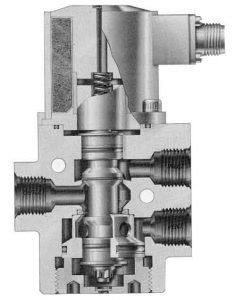Hydracon Subsea Solenoid Valves
Precision valve balancing and a short valve stroke translate to low solenoid actuation force over a short solenoid air gap, resulting in small, high flow, low wattage fast response solenoid valves.
- Shock and vibration resistant. No adjustments and screws to vibrate loose. Stroke control across flat metallic surfaces eliminates the need for adjustments and prevents seat impacting.
- The resilient seats are separate from the stroke control, resulting in high resistance to damage from shock and vibration.
- Small size. Smaller valves utilizing smaller solenoids are the result of the combination of precision pressure balancing and short valve stroke.
- Bubble-tight seat closure. Resilient seats provide “zero” leakage.
- Contamination tolerant seats. Resilient seats resist damage and provide high tolerance to contamination, allowing for particles to 1000 micron.
- Full flow and low pressure drop. The seats are located on the O.D. of the spool to provide low pressure drop.
- Precision pressure balanced seats and piston seals are on accurate and equal diameters, providing for low operating forces.
- Corrosion resistant metals are compatible with the fluid.
- Electron beam welded hermetically sealed solenoid construction.
- Underwater connector: Underwater connectors are usually on the top of the solenoid, for use in extreme ocean depth.
- Fluid pressures to 6,000 psi differential for resilient seat valves. (Other valve options include metallic hard seat designs and non-extrusion resilient seat designs capable of differential pressures to 20,000 psid.)
- Soft seat valve designs are very efficient and result in smaller solenoids.
- Hermetically sealed. Welded construction eliminates the problems associated with threads and O-rings.
- Corrosion resistant. Constructed of magnetic and non-magnetic stainless steels, eliminating the problems of electroplating and corrosion.
- Underwater connector. Underwater connectors, usually welded to the top of the solenoid, for use to extreme ocean depth.

OPERATION OF BALANCED SOLENOID VALVES
Technical Bulletin 105
When power is applied to the Solenoid (1) of a valve in the normal or de-energized position, the Armature (2) is stroked upward, pulling the Poppet Assembly (3) with it. When the power is removed, the Poppet Assembly (3) and Armature (2) are pushed downward by the Spring (4). The Shoulder Stops On the Poppet Assembly control this movement within precise limits providing optimum seat indentation and armature head space (when solenoid is energized). This assures low pull-in and high drop-out voltages and unrestricted flow through the valve when in the open position.
Essential to balanced pressure operation is the maintenance of an exact seating area. Although it is relatively easy to balance pressure forces with dynamic bore seals, it is extremely difficult to maintain exact sealing areas with a Resilient Valve Seat.
In the de-energized or energized positions, pressures are retained between two O-rings (the valves use O-rings for seats and dynamic seals) whose effective sealing areas are equal. For this reason, pressure forces acting on the Poppet Assembly are equal and opposed. Pressure balancing in this manner minimizes and stabilizes Solenoid and Spring forces required for valve actuation over the entire operating pressure range. Static and dynamic o-ring friction resulting from pressure is kept to a minimum by special Back-up Rings that also prevent extrusion of the o-rings at high pressures.
